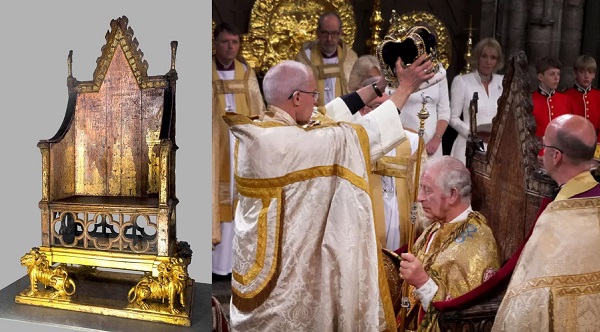ISABEL RUBIO ARROYO | Tungsteno
The Coronation Chair of Charles III is the oldest piece of furniture in Britain still in use for its original purpose. Located in Westminster Abbey’s St. George’s Chapel, it has been used in the coronation ceremonies of 39 monarchs and has undergone delicate conservation work. We analyse the history and secrets of one of the most precious and famous pieces of furniture in the world.
A chair that houses a sacred stone
This iconic piece of oak furniture, standing over two metres tall, was constructed between 1297 and 1300 by order of King Edward I. Its purpose was to create a relic case to house the famous Stone of Destiny, also known as the Stone of Scone. This 152kg rectangular block of red sandstone is considered a sacred object and an ancient symbol of the monarchs of Scotland, having been used for centuries to inaugurate its kings.
"The stone is now kept in Scotland, although chair and stone are reunited for coronations," explains Susan Jenkins, curator of Westminster Abbey. Edward II was the first king to use the chair at his coronation in 1308. The most recent was Charles III of the United Kingdom, who inherited the throne on the death of his mother, Elizabeth II, and was crowned king at the age of 74 with his wife, Camilla, on 6 May 2023.
Charles III was crowned King of the United Kingdom on 6 May 2023 at Westminster Abbey. Credit: BBC
From schoolboy graffiti to a bombing
The chair was painted by King Edward I's royal painter, Walter of Durham, and highly decorated. The wood was originally covered in a thin coating of gold, with motifs of plants, birds and other animals on a gilded background, and the figure of a king painted on the back. "It is one of the oldest surviving artefacts associated with coronations for which we have a complete provenance," RM Morris, honorary senior research associate at the Constitution Unit of University College London, tells Architectural Digest.
In its more than seven centuries of history, the famous chair has undergone various alterations, as Westminster Abbey notes: "From the ornate addition of four gilt lions, the national animal of England, in the early 16th century to the destructive graffiti on the back of the chair by Westminster schoolboys and visitors to the Abbey in the 18th and 19th centuries." One of the tourists carved "P. Abbott slept in this chair, 5-6 July 1800" on the seat. In addition, a bomb attack in 1914—allegedly by a group of suffragettes—damaged one of the corners.
This iconic piece of oak furniture stands over two metres tall and contains a sacred stone during coronations. Credit: Westminster Abbey
Conservation work to restore the chair to its former glory
The chair has also undergone several rounds of conservation and cleaning. In 2010, while such work was being carried out, small traces of vivid colours were found on it, new wooden tracery was fitted to the front of the chair—the original had been missing since the 18th century—and it was discovered that there was originally no seat. "A cushion on top of the Stone was probably used in earlier times," Westminster Abbey explains.
This year, a few months before Charles III's coronation, Westminster Abbey restorers used sponges and swabs to clean the chair and stabilise the gilding, Kristia Blessley, the Abbey's paintings conservator, told the Daily Mail. "It's so important to our country’s history and in the history of the monarchy, and it's really unique as a conservator to work on something that is part of a working collection and still used for the original function it was made for," she said.
Despite all the changes it has undergone, "the chair remains the place where the monarch sits in the moment they are crowned, marking a tradition and a connection to all those who have come before them," says Westminster Abbey. Jenkins explains that the chair is placed facing the high altar and the monarch sits with their back to the congregation. "This emphasises the religious nature of the coronation service," she adds. In a ceremony attended by more than 2,000 guests, Charles III became the latest monarch to be crowned. Seated in this chair and wearing a crown weighing more than two kilos and studded with precious stones, he heard the words: "God save the King".
· — —
Tungsteno is a journalism laboratory to scan the essence of innovation.
